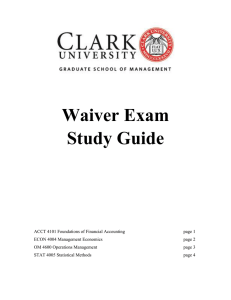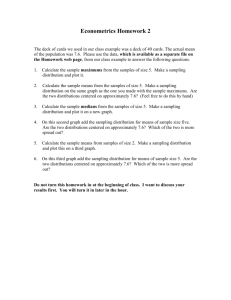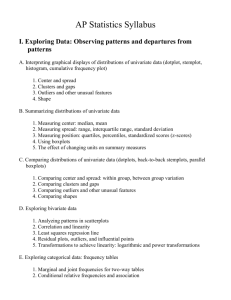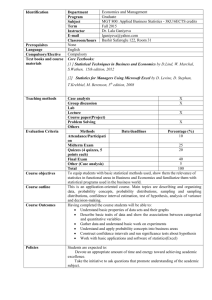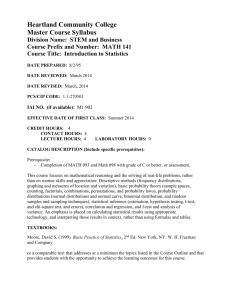Waiver Exam Study Guide 1
advertisement
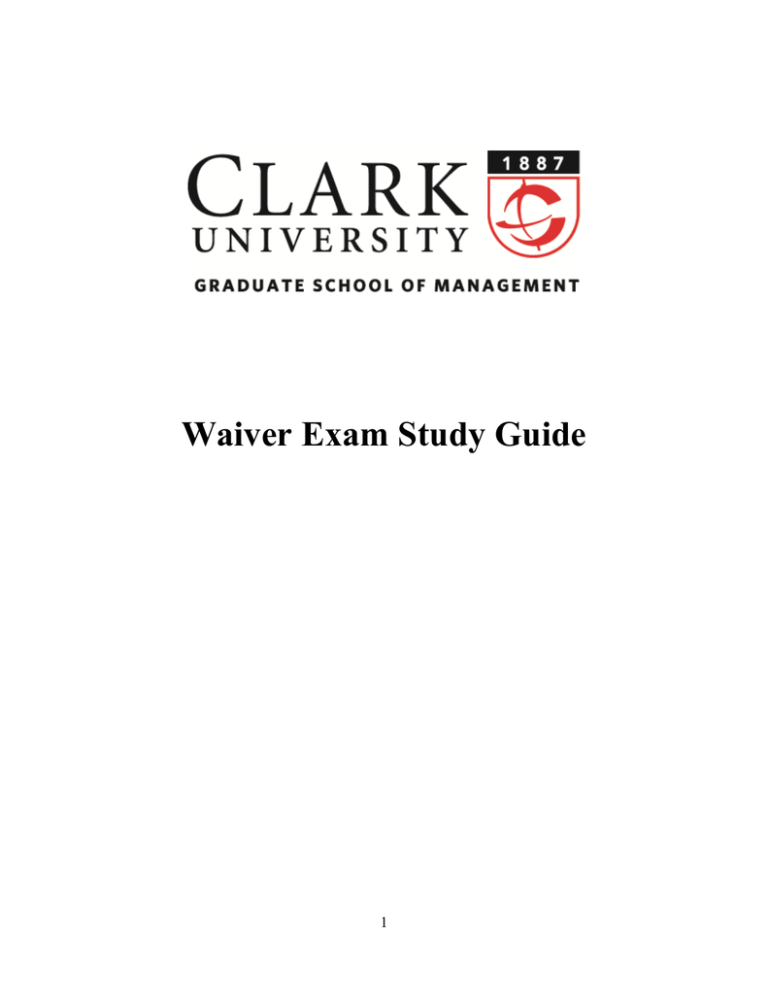
Waiver Exam Study Guide 1 MGMT 4708 - Contemporary Business Law This course will provide an understanding of the court systems, common law contract formation, Uniform Commercial Code Sales of Goods contracting, partnerships, corporations, tort liability and hidden ethical issues in the law. The concepts are powerful. Please rest assured that you will never look at business the same way again. TOPICS - Law Systems and Courts Contract Formation and the Role of Contracts in Modern Business Uniform Commercial Code Sales Law Agency, Partnership Relationships and Responsibilities Corporation Law and Practice Torts and Strict Liability Intellectual Property Components of the Law Ethical Issues in Modern Corporations 2 FIN 4200 - Financial Management TOPICS Introduction to Corporate Finance Financial Statements and Cash Flow Financial Statements Analysis and Long Term Planning Discounted Cash Flow Valuation Bond and Stock Valuation Net Present Value and Other Investment Rules Making Capital Investments Decisions Risk Analysis, Real Options and Capital Budgeting Lessons from Market History The Capital Asset Pricing Model The Arbitrage Pricing Theory Risk, Cost of Capital and Capital Budgeting Efficient Capital Markets Long Term Financing Capital Structure Basic Concepts Limits to the Use of Debt Dividends and Other Payouts Issuing Securities to the Public Options and Corporate Finance Options Applications Warrants and Convertibles Derivatives and Hedging Risk Mergers and Acquisitions Financial Distress 3 ACCT 401 – Foundations of Accounting The following information is provided to students who are planning to take the waiver examination. 1) You will improve your chances of passing the examination if you were to review the material covered by the examination. 2) If you have taken accounting courses outside the United States, it is very important that you familiarize yourself with the U.S. accounting system and accounting terms. There can be substantial differences in different accounting systems. 3) The examination emphasizes concepts rather than detail procedures. It reflects the course (ACCT 4100) emphasis which is to teach managers how to use accounting information. 4) The following topics will be covered in the exam: a) Intuitive explanations of balance sheet, income statement and cash flow statement. b) Accounting equation, how transactions affect accounting equation, accounting cycle, journal entries, journals and ledgers, worksheet calculations and preparation of financial statements. c) Accruals, deferrals, adjusting entries. d) Accounting principles, assumptions and exceptions. e) Current assets, cash, accounts receivable, marketable securities. f) Inventories, different cost-flow assumptions. g) Long-lived assets, acquisition, depreciation and disposal, intangible assets. h) Current liabilities. i) Long-term notes & bonds and leases (present value calculations are not required for the exam). j) Stockholders equity and its components. k) Cash flow statement in detail. l) Different ratios in analysis of balance sheet and income statement. 5) The exam will consist of problems and essay questions. 6) Any book that uses U.S. accounting system and written for a first course in financial accounting for MBAs may be appropriate. The book must be of a recent vintage, preferably written after 1993. Management accounting topics are not covered in the exam. If you are unable to find a text written for MBAs, one written for undergraduates may be used. 4 Econ 4004 – Management Economics COURSE DESCRIPTION Managers of organizations – whether for-profit, nonprofit, or government agencies – face a common set of resource allocation problems. This course will develop a student’s ability to formulate and solve these problems, drawing upon the economic theories of consumer demand, the firm and industrial organization as well as mathematical optimization techniques. It will provide a framework for analyzing the flexible multiproduct firm as well as competitive and cooperative business situations from a strategic (game theoretic) perspective. Topics to be surveyed include: demand analysis, production and cost analyses, flexible manufacturing, market structure and strategic behavior, pricing practices, government regulation, and decision making under uncertainty. OBJECTIVES By the time you complete this course, you should be able to 1. Understand basic principles of international economics. 2. Interpret the diagrams, tables and figures in the assigned chapters, and by extension, in other books and articles. 3. Read an article in the financial pages of a daily newspaper, and comment critically on the positions taken by the article’s author(s) in relation to economic principles. 4. Utilize economic principles in making business decisions. TOPICS Demand Curves and Profit Maximization Cost curves (TC, AC, MC). Factors of production, intermediate goods. Asset Markets Money and Time Monetary and Fiscal Policy Role of Government in the Economy 5 MIS 4500 - Management Information Systems COURSE OBJECTIVES Management Information System is an introductory course intended for those whose responsibility will involve in deciding whether and when to invest in information systems, and how to develop and manage information systems. As such, the course will examine strategic, organizational, technological, as well as managerial issues that are relevant to information systems. The course is divided into four major sections. The first section, Information Systems Strategy, addresses why information systems (IS) and information technology (IT) are important and how they can be employed to help firms profit and survive. The objective for this section is to ensure that the student is able to identify ways to improve organizational performance through the use of technology and techniques such as business process reengineering. The second section, Information Systems Technology, deals with the basic technology components of information systems. The objective of this section is to introduce concepts that can help students to identify what technologies will be required and how they can be integrated to meet the business requirements. The third section, Information Systems Applications, focuses on different types of systems, what they are, how they differ, where in the organization they are used and by whom, and how a firm determines what type of information systems will be required as well as when they will need to be available to meet market and business drivers in both the near and distant future. The final section Information Systems Implementations, deals with how the various systems can be best implemented and managed. As a result of the material covered in this section, the student will be able to plan for and develop an information system. TOPICS IS Strategy IS Technology—Managing Data Resources IS Tech—Telecommunications and Networking IS Technology—Wireless and Security IS Applications—E-Commerce IS Applications—Enterprise Applications IS Applications—Knowledge Management IS Applications—Decision Support Systems IS Implementation/Management Business Value International IS-Ethical and Social Issues 6 MGMT 230 - Marketing Management COURSE OBJECTIVES The main objective of this course is (1) to introduce students to marketing by providing key marketing terms, fundamental concepts, and principles and (2) to enable students to understand and analyze real marketing issues and problems. The content will focus on the analysis of marketing activities in consumer, reseller, industrial, government, and service markets. In addition, after you complete this course, you will be more knowledgeable about particular companies/organizations as well as the importance of marketing to organizations and other business functions. This course will make you a better consumer by helping you better understand marketing theories, strategies, and tactics. Likewise, this course will make you a better employee for the organizations you are employed by throughout your career. When completed, this course will help you understand how marketing concepts and tools can help any organization be more successful. You will be able to make better purchase decisions (or at least more knowledgeable ones) for you and your family. Lastly, you will better understand how information technology is impacting the field of marketing. TOPICS Foundations of Marketing Marketing Environment Marketing in the Internet Age Strategic Planning Competitive and Marketing Intelligence Marketing Research Consumer Buying Behavior Business Buying Behavior Market Segmentation and Targeting Positioning Product, Services and Branding Strategy Developing and Managing New Products Product Life-Cycle Pricing Factors and Approaches Pricing Strategies Distribution Channels Supply Chain Management Retailing and Wholesaling IMC: Advertising, Sales Promotions and PR IMC: Personal Selling and Direct Marketing International Marketing 7 OM 4601 - Operations Management COURSE OBJECTIVES For domestic or international organizations to maintain a competitive advantage over their global competitors, a strong foundation based on maintaining and improving productivity and efficiency is essential. Critical to this goal is the management of resources within an organization. This class introduces the student to the management of productive resources. It surveys the planning, design and control of systems responsible for productive use of raw materials, human resources, technology, equipment and facilities in the development of a product or service. There is an attempt to balance the focus between quantitative tools and qualitative presentation, with emphasis on class case discussion in the presentation of material in this course. It is assumed that the student has some basic quantitative tools (e.g. linear algebra and statistics). Course topics will begin with a discussion of strategic issues, with the discussion incorporating operations (manufacturing) strategy, and organizational operations planning for manufacturing and services. Total quality, process, location analysis, and capacity management make up additional strategic and tactical planning topics. Other tactical and operational issues include forecasting, aggregate planning, scheduling and supply chain management. TOPICS Introduction to Operations Management and Operations Strategy Process Analysis - Manufacturing Quality Management/Quality Assurance and Tools Quality/Capacity/Process Issues Forecasting and Location Analysis The Beer Game - Supply Chain Management 8 Stat 4005 – Statistical Methods This is a first course in applied statistics. No prior knowledge of statistics is assumed. Topics covered include introduction to business statistics, data analysis and presentation, descriptive statistics, probability theory and introduction to statistical sampling. OBJECTIVES The major objectives of Stat 4005 include: 1. Appreciate why statistics is an important topic for business decision making 2. Learn how to use graphics and descriptive statistics to summarize statistical data into information meaningful for decision making 3. Apply basic probability theory to statistical and business decisions. 4. Understand why statistical sampling is important and how to best apply statistical sampling techniques to business applications. 5. Establish the foundation necessary to advance to Stat 4006. The major objectives of Stat 4006 include: 1. Develop a further understanding of statistical sampling, including how to select a sample and determine an appropriate sample size. 2. Learn how to develop and conduct hypotheses tests. 3. Apply basic concepts involving experimental design, differences between population means, and analysis of variance. 4. Understand the basics of simple linear regression analyses. The combined objectives of STAT 4005 and STAT 4006 prepare you to manage a business using statistics to make decisions. These objectives will help you better understand the theory of risk and uncertainty, ask good questions using statistical analyses, and help you understand the strengths and limitations of statistical analyses. TOPICS - Statistics and decision making in business: an introduction Descriptive statistics: tabular and graphical presentations Descriptive statistics: numerical measures Introduction to probability: combinations, permutations, independent events, addition and multiplication laws, Bayesian analysis Discrete probability distributions: expected value and variance, binomial and Poisson distributions Continuous probability distributions: discrete vs. continuous probability distributions, uniform and normal probability distributions. Sampling and sampling distributions: selecting a sample, point estimation, sampling distributions, other sampling methods. Interval estimation: population means, determining sample size, population proportions. Hypothesis tests: null and alternative hypotheses, type I and type II errors, population mean, population proportion. Comparisons involving means: experimental design, analysis of variance. Comparisons involving proportions: populations proportions, multinomial proportions, tests of independence. Simple linear regression: linear regression model, least squares method, coefficients of determination and correlation, testing for significance. 9

